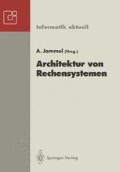Abstract
Clans are introduced as a basic concept of an operating system kernel. They permit full algorithmic control of process interaction in a user definable but secure way. All communication across a clan’s borderline is inspected and possibly modified by the clan’s so called chief task. Thus the mechanism can be used for protection, remote communication, debugging, event tracing, emulation, connecting heterogeneous systems and even process migration. It has been implemented in the operating system L3 where, besides some smaller applications, remote message handling and a multi-level-security monitor rely on clans.
Access this chapter
Tax calculation will be finalised at checkout
Purchases are for personal use only
Preview
Unable to display preview. Download preview PDF.
References
M.Accetta, R.Baron, W.Bolosky, D.Golub, R. Rashid, A.Tevanian, M.Young: ”Mach: A New Kernel Foundation for UNIX Development”, in Proc. Summer Usenix. July, 1986.
F.Baskett, J.H. Howard, J.T. Montague: ”Communication in Demos”, in Proc. Sith Symposium on Operating System Principles, Purdue 1977, Operating Systems Review 11,5
U.Beyer, D.Heinrichs, J.Liedtke: ”Dataspaces in L3”, in Proc. MIMI ’88. Barcelona, July, 1988.
P.Brinch Hansen: ”Operating Systems”, Englewood Cliffs, 1973
”EUMEL Benutzerhandbuch”, University of Bielefeld. Bielefeld, 1979
H.Härtig, W.Kühnhauser, W.Lux, H.Streich, G.Goos: ”Structure of the BirliX Operating System”, in GMD Jahresbericht 1985. St Augustin, 1986
O.Kowalski, H.Härtig: ”Protection in the BirliX Operating System”, in Proc. 10th International Conference on Distributed Computing Systems. 1990
H.C. Lauer, R.M. Needham: ”On the Duality of Operating System Structures”, in Proc. Second International Symposium on Operating Systems, IRIA, Oct. 1978, reprinted in Operating Systems Review, 13,2, April 1979
J.Liedtke: ”An Overview on the L3 Operating System”, in Proc. MIMI ’88. Barcelona, July, 1988.
J.Liedtke, U. Bartling, U. Beyer, D. Heinrichs, R. Ruland, G. Szalay: ”Two Years of Experience with a ü-Kernel Based OS”, in Operating Systems Review 2/91.
J.Liedtke: ”Clans & Chiefs — A New Kernel Level Concept for Operating Systems”, GMD Tech Report No 579. St. Augustin, 1991.
J.Liedtke: ”Fast Interprocess Communication in the L3 Operating System”, in preparation.
J.Liedtke: ”Task Migration Using Clans”, in preparation.
K.Loepere (Ed.): ”Mach 3 Kernel Interface, Revision 0.5”, Open Software Foundation and Carnegie Mellon University, 1990.
S.J. Mullender, G. van Rossum, A.S. Tanenbaum, R. van Renesse, J.M. van Staveren: ”Amoeba — A distributed operating system for the 1990s”, Centrum voor Wiskunde en Informatica, Report CS-R9004, Amsterdam 1990.
National Computer Security Center: ”Trusted Computer System Evaluation Criteria” (Orange Book), DOD 5200.28-STD, Washington 1985
R.Rashid, G.Robertson: ”Accent: A communication Oriented Network Operating System Kernel”, in Proc. 8th Symposium on Operating System Principles. December, 1981
M.Young, A.Tevanian, R.Rashid, D.Golub, J.Eppinger, J.Chew, W.Bolosky, D.Black, R.Baron: ”The Duality of Memory and Communication in the Implementation of a Multiprocessor Operating System”, in Proceeedings of the 11th Symposium on Operating System Principles, November 1987
Zentralstelle für Sicherheit in der Informationstechnik: ”IT-Sicherheitskriterien” (Green Book), Bundesanzeiger Nr. 99a, Küln, 1989
Author information
Authors and Affiliations
Editor information
Editors and Affiliations
Rights and permissions
Copyright information
© 1992 Springer-Verlag Berlin Heidelberg
About this paper
Cite this paper
Liedtke, J. (1992). Clans & Chiefs. In: Jammel, A. (eds) Architektur von Rechensystemen. Informatik aktuell. Springer, Berlin, Heidelberg. https://doi.org/10.1007/978-3-642-77422-5_25
Download citation
DOI: https://doi.org/10.1007/978-3-642-77422-5_25
Publisher Name: Springer, Berlin, Heidelberg
Print ISBN: 978-3-540-55340-3
Online ISBN: 978-3-642-77422-5
eBook Packages: Springer Book Archive

